An Electrical Worker Dies When He Falls Through a Skylight While Installing Solar Panels on the Roof of a Warehouse
California Case Report: 09CA003
Summary
AA 46-year-old electrical worker died when he fell through a skylight on a roof while installing solar panels. The victim was carrying solar panels and walking backwards because of the limited space around the skylight. As the victim was walking backwards, he tripped on the raised edge of the skylight frame and fell onto the skylight. The skylight glazing (the transparent portion of the skylight) broke under the impact and the victim fell approximately 40 feet to the ground below. Although the skylight label indicated that it was tested in accordance with OSHA fall protection standards, there are currently no uniform test criteria to determine material strength to withstand worker impact. The CA/FACE investigator determined that in order to prevent future incidents, employers of workers who install solar panels on roofs with skylights should:
- Develop, implement, and enforce a fall protection program to prevent falls through skylights.
Introduction
On Monday April 6, 2009, at approximately 2:00 p.m., a 46-year-old electrical worker died when he fell through a skylight approximately 40 feet to the ground below. He was installing solar panels on the roof of a warehouse when the incident occurred. The CA/FACE investigator was notified of this incident on May 8, 2009, from the Department of Investigations of the Division of Occupational Safety and Health (Cal/OSHA). On June 15, 2009, the CA/FACE investigator interviewed the risk manager of the electrical contractor that employed the victim. Telephone interviews were conducted on July 2, 2009, with the local union business manager, one co-worker of the victim, and a sales manager of the skylight manufacturer. A site visit was performed on July 29, 2009. The CA/FACE investigator reviewed the electrical contractor’s safety policies and procedures, training program, and the victim’s orientation and training records.
The victim was a member of the local electrical union with eight years of work experience. He had been employed with the electrical contractor for seven days when the incident occurred. The electrical contractor had been in business for 46 years and had 800 employees. There were 33 employees at the site the day the incident occurred. The employer had a complete written Injury and Illness Prevention Program (IIPP) which included sections on working from elevations, fall hazard awareness, and fall protection. They also had a written training program. The victim had received employee orientation and safety awareness training on the first day of hire. The victim also attended daily site-specific safety awareness tailgate meetings for the site at which they were working.
Investigation
The site of the incident was a flat roof of an active warehouse with a surface area of approximately 650,000 square feet. There were a total of 357 skylights on the roof. Alternate rows of skylights were sealed closed and had stamped ratings; the other rows had skylights that opened and had antitheft grating underneath. This solar panel rooftop installation was designed to produce approximately one megawatt of electricity for the Southern California area. In order to do this, 16,272 solar panels were being installed on the vacant area of the roof between the rows of skylights. The foundations for the solar panels were in close proximity to the skylights and workers had approximately 18 inches of clearance to maneuver around the skylights as the system was being built. The workers also had to be aware of the weight restriction on the roof, as they were not allowed to exceed 300 pounds per square foot.
On the day of the incident, the victim and his co-worker were carrying and installing electrical solar panels on the roof of the warehouse. No fall protection was used as the skylights were marked as being in accordance with OSHA fall protection standards. The solar panels were boxed and placed on the roof by a crane. Each panel was approximately two feet wide by four feet long, and weighed 24 pounds. At approximately 2:00 p.m., the victim and co-worker were carrying two panels at a time. As they approached a skylight, they had to maneuver around it using the 18 inches of clearance. The victim turned and walked backwards, and tripped on the raised edge of the skylight. He landed on the skylight in a sitting position and then, without warning, the plastic dome glazing broke. As the victim started to fall, a co-worker reached out and tried to grab his foot, but was unable to reach him in time. The victim fell approximately 40 feet to the warehouse floor below. Numerous workers with radios immediately called the office to report the incident and those with cell phones immediately called 911. The paramedics and fire department responded within minutes and pronounced the victim dead at the scene.
Cause of Death
The cause of death according to the death certificate was multiple blunt force injuries.
Recommendations/Discussion
Employers who use machines that recycle waste products should ensure that:
Recommendation #1: Develop, implement, and enforce a fall protection program to prevent falls through skylights.
Discussion: In this particular incident, the skylight was marked by the manufacturer that it was “tested in accordance” with OSHA fall protection standards. According to the employer’s risk manager, the general contractor had reviewed the job safety requirements including fall protection plans. Based on the information that the skylight had been tested in accordance with OSHA standards, no other fall protection measures were implemented on this job site. There are currently no uniform test criteria to determine material strength of skylights to withstand worker impact. Such test criteria would include the degradation of plastic or plastic containing materials after several years of sun exposure and the ability to withstand a point impact. One organization, ASTM International, is currently developing such testing guidelines. At this time, employers should not assume that manufacturer testing ensures that a particular skylight can sustain the impact of a worker. In order to prevent falls through skylights, employers should implement and maintain a fall protection program that includes:
- Skylight screens capable of safely supporting the greater of 400 pounds or twice the weight of the employees plus his equipment and materials, or
- Guardrails around the skylight at least 45 inches in height with a top rail and mid rail which should be half way between the bottom surface and top rail. The rails should be able to withstand a live load of 20 pounds per square foot.
If these two methods are not feasible, then the use of personal fall protection should be utilized. A personal fall protection system consists of a body harness, lanyard and anchor points. Had any of these fall protection methods been used at this job site, the victim would not have fallen through the skylight to the ground below.
References
General Industry Safety Orders Article 2. Standard Specifications. §3209. Standard Guardrails. §3212. Floor Openings, Floor Holes and Roofs. (b)(e) Subchapter 4. Construction Safety Orders
Construction Safety Orders Article 24. Fall Protection. §1632. Floor, Roof, and Wall Openings to Be Guarded. §1670. Personal Fall Arrest Systems, Personal Fall Restraint Systems and Positioning Devices.
http://www.energy.ca.gov/links/base.php?pagetype=solar (link not available)
http://www.aamanet.org/general.asp?sect=1&id=291external icon
http://www.astm.org/DATABASE.CART/WORKITEMS/WK17797.htmexternal icon
Exhibits
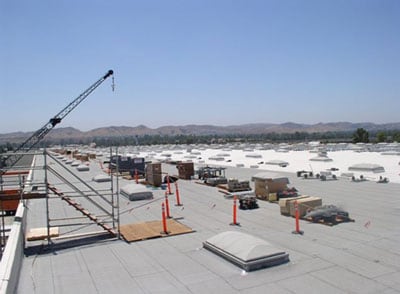
|
|
Exhibit 1. The rooftop looking south.
|
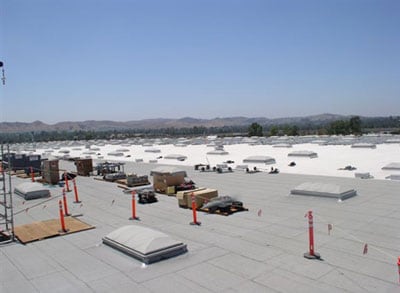
|
|
Exhibit 2. The rooftop looking west.
|
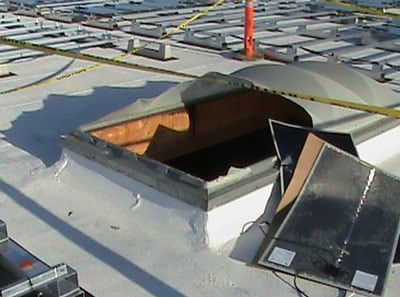
|
|
Exhibit 3. The skylight the victim fell through.
|
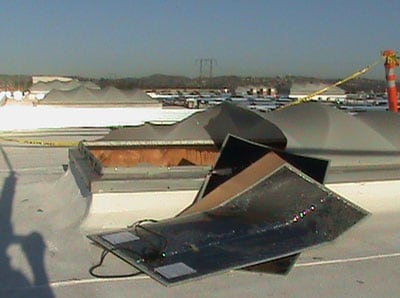
|
|
Exhibit 4. The solar panels that the victim was carrying when he tripped.
|
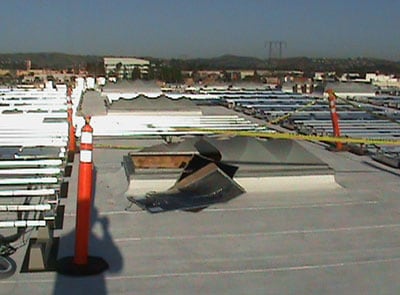
|
|
Exhibit 5. A view of the incident scene and the base foundations for the solar panels.
|

|
|
Exhibit 6. The identification tab on the skylight the victim fell through. |
California Fatality Assessment and Control Evaluation (FACE) Project
The California Department of Public Health, in cooperation with the Public Health Institute and the National Institute for Occupational Safety and Health (NIOSH), conducts investigations of work-related fatalities. The goal of the CA/FACE program is to prevent fatal work injuries. CA/FACE aims to achieve this goal by studying the work environment, the worker, the task the worker was performing, the tools the worker was using, the energy exchange resulting in fatal injury, and the role of management in controlling how these factors interact. NIOSH-funded, state-based FACE programs include: California, Iowa, Kentucky, Massachusetts, Michigan, New Jersey, New York, Oregon, and Washington.
To contact California State FACE program personnel regarding State-based FACE reports, please use information listed on the Contact Sheet on the NIOSH FACE web site. Please contact In-house FACE program personnel regarding In-house FACE reports and to gain assistance when State-FACE program personnel cannot be reached.
